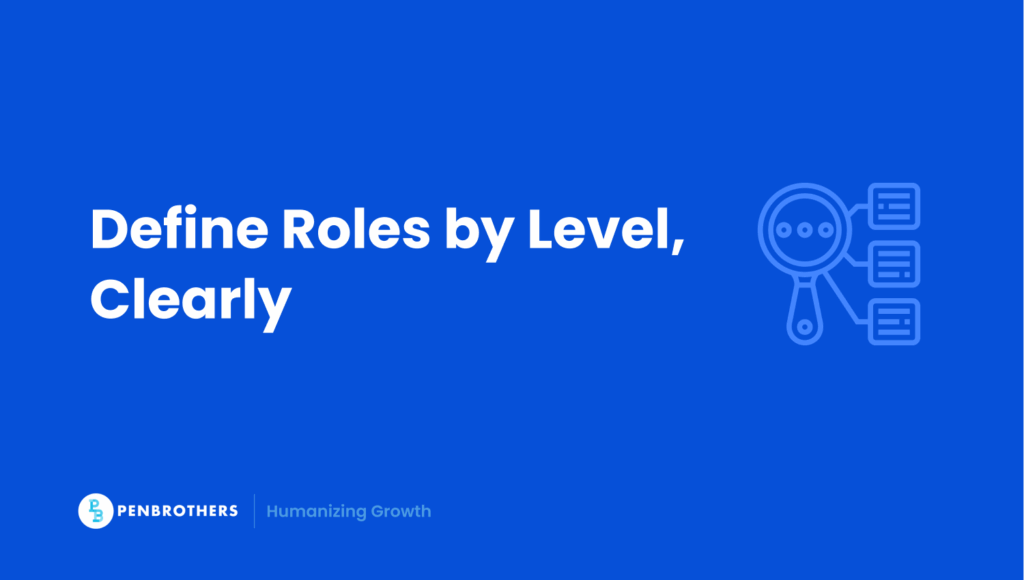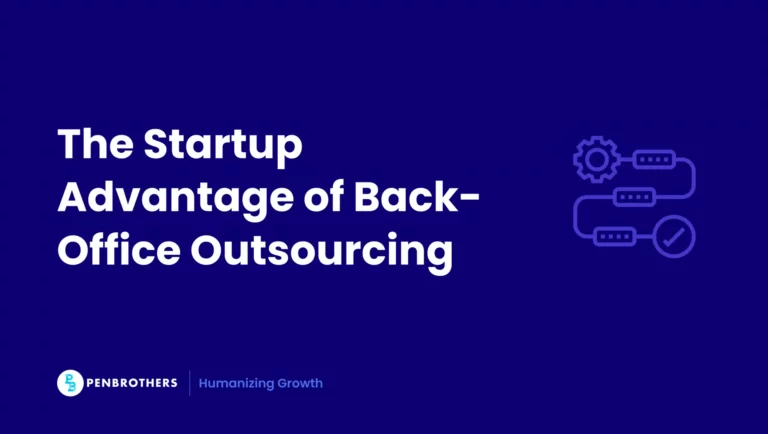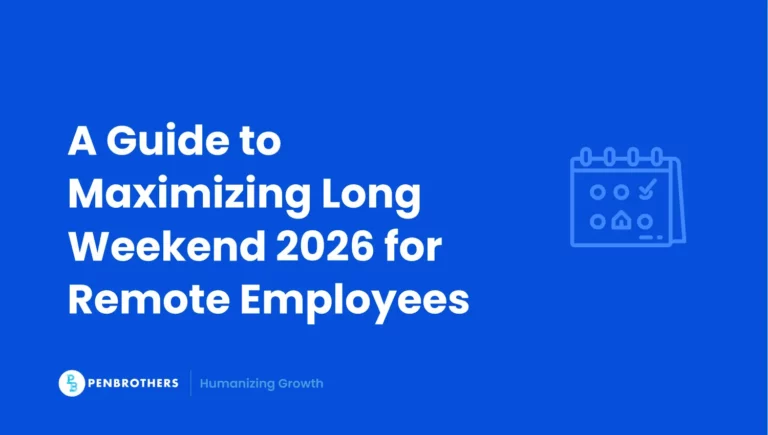Job titles may differ, but the need for clarity doesn’t. Whether you’re hiring your first employee or restructuring a global workforce, defining job levels is more than a formality; it’s a business advantage. Entry-level roles are where careers begin, but without a structured path, they may also be where potential stalls. That’s why starting with well-crafted role descriptions is essential, they lay the groundwork for accurate classification and long-term talent growth.
For organizations embracing offshore staffing or scaling distributed teams, clarity around job levels creates a common language. At Penbrothers, we help clients build this language from the ground up, ensuring their outsourced teams are classified not just by cost, but by contribution. Explore how we help companies find, hire, and build their offshore teams.
Key Takeaways
- A Strategic Tool for Scalable Growth: Job level classification is a strategic framework, not just an administrative task. It provides the consistency, clarity, and fairness needed for scalable hiring, equitable compensation, and transparent career development, which is especially critical for companies with global or offshore teams.
- A Clear Hierarchy Exists from Entry Level to Executive: A standard classification system follows a predictable progression of roles. This hierarchy typically moves from Entry Level (learning fundamentals), through various Individual Contributor stages (junior, mid, senior), to Team Leadership, Department Leadership, and finally Executive (C-Level) leadership.
- Objective and Measurable Criteria are Essential: Roles should be classified using objective criteria, not subjective feelings. The key factors to consider are the scope of responsibilities, the required competency levels (both technical and behavioral), the degree of decision-making authority, and the role’s overall organizational impact.
- Job Families Create Transparent Career Paths: A best practice is to organize roles into job families (e.g., Marketing, Engineering, Finance). This creates clear and transparent career progression paths, which helps with employee engagement and retention by showing them a clear route for growth within their specific discipline.
What is Job Level Classification?
Job level classification is a structured way to categorize roles based on experience, skill, responsibility, and impact. Think of it as a roadmap for organizational design. It brings consistency to your job titles, compensation plans, performance evaluations, and succession strategies.
With job classification:
- You define what “entry level” really means.
- You align roles with real business outcomes.
- You future-proof your talent strategies as your organization scales.
Mercer’s Global Job Architecture Pulse Survey highlights that over half (54%) of organizations feel their job architecture enables career development and mobility, indicating a positive impact on internal talent movement.
What Are The Levels of Jobs?
Understanding the standard hierarchy of job levels provides the foundation for any effective job level classification system. While organizations customize their structures, most follow a predictable pattern that reflects increasing responsibility, autonomy, and impact.
The entry level encompasses roles designed for new graduates or career changers with minimal industry experience. These positions focus on learning fundamental skills, following established processes, and contributing to team objectives under close supervision. Examples include Administrative Assistant, Junior Analyst, or Associate roles across various functions.
Individual contributor levels represent the career progression for specialized professionals who develop expertise without managing others. These roles typically span three sub-levels: junior (1-3 years experience), mid-level (3-7 years), and senior (7+ years). A Software Developer might progress from Developer I to Developer III, gaining technical depth and project ownership along the way.
Team leadership levels mark the transition to people management, where professionals combine their functional expertise with leadership responsibilities. These roles include Team Lead, Manager, or Supervisor titles, typically managing 3-15 direct reports while maintaining hands-on involvement in their specialty area.
Department leadership encompasses Director and VP-level positions responsible for entire functional areas. These leaders set strategy for their domains, manage multiple teams, and coordinate with other departments to achieve organizational objectives. Their decisions affect hundreds of employees and significant budget allocations.
Executive leadership represents the C-suite positions responsible for enterprise-wide strategy and performance. These roles include CEO, CFO, CTO, and other Chief-level positions that shape organizational direction and bear ultimate accountability for business outcomes.
Understanding these levels becomes crucial for job level classification because each tier requires different competencies, compensation approaches, and performance expectations. The framework provides common language that works across industries, geographies, and organizational structures.
Job Classification vs. Job Grading: What’s the Difference?
The terms are often used interchangeably, but they serve different purposes.
Job classification groups similar roles based on shared traits like tasks, qualifications, and responsibilities. These are labeled with clear, descriptive titles such as Administrative Assistant or Software Developer.
Job grading, on the other hand, uses numeric or alphabetic scales to rank roles. It’s more focused on comparative weight factoring in skills, decision-making scope, and organizational impact.
For instance, Whereby uses a 7-level system ranging from entry level to C-suite:
- Level 1: Inaugurate
- Level 2: Associate I, Associate II
- Level 3: Partner I, Partner II
- Level 4: Lead I, Lead II
- Level 5: Director
- Level 6: VP
- Level 7: C Suite
This type of framework can help standardize job roles across markets especially valuable when working with offshore staffing partners like Penbrothers.
Typical Job Levels: From Entry Level to Executive
Organizations may customize levels, but these tiers are most common:
- Entry Level: Fresh graduates, junior staff, and early-career professionals. These roles are task-oriented, supervised, and often the training ground for future leaders.
- Mid-Level: Specialists, analysts, or coordinators who take ownership of small projects or manage junior team members.
- Senior-Level: Experienced professionals making department-level decisions or leading major initiatives.
- Managerial: Leaders managing teams, departments, or processes. Strategic focus begins here.
- Director & Executive: Responsible for aligning their function with company-wide objectives. Vision-driven and outcome-oriented.
The OECD Employment Outlook 2023 highlighted that organizations implementing well-defined job ladders and progression paths saw better retention, especially at the mid-level tier.
What Is a Level 3 Position?
Level 3 positions represent the crucial middle tier in most job level classification systems, typically occupied by experienced individual contributors or emerging leaders who’ve moved beyond junior status but haven’t yet reached senior management roles.
In a standard five-level job level classification framework, Level 3 professionals possess 3-7 years of relevant experience and demonstrate mastery of core job functions. They work with minimal supervision, own complex projects from conception to completion, and often mentor junior team members. These roles require both technical competence and developing business acumen.
The responsibilities that define Level 3 positions include project ownership where they manage timelines, resources, and stakeholder communication for significant initiatives. They identify problems proactively and develop solutions rather than simply executing predefined tasks. Cross-functional collaboration becomes essential as they work with other departments to achieve shared objectives.
Decision-making authority at Level 3 typically covers tactical choices within established strategic frameworks. They can approve moderate expenditures, adjust project scope based on changing requirements, and make hiring recommendations for their teams. However, they operate within budget and policy parameters set by senior leadership.
Compensation for Level 3 positions reflects their value as proven performers who reduce management overhead while driving meaningful business outcomes. In most markets, these roles command a significant salary premium over entry-level positions, with additional compensation often tied to project success or team performance metrics.
Career progression from Level 3 usually branches into two paths: continued individual contribution toward senior specialist roles or transition into formal people management positions. The job level classification system should clearly define both pathways to prevent career stagnation and retain high-performing professionals.
Examples of Level 3 positions across functions include Marketing Specialist, Financial Analyst, Software Developer, Customer Success Manager, or HR Business Partner. While titles vary, the common thread involves independent project ownership, cross-functional collaboration, and mentoring responsibilities that bridge junior and senior organizational levels.
Job Families and Career Progression Paths
A job family is a group of roles that share a similar functional discipline, skillset, and general purpose, even if the specific responsibilities differ by level. Think of it as an internal ecosystem where each role is a rung on a well-structured ladder. Common job families include Marketing, Finance, Engineering, Customer Success, and Human Resources.
Organizing roles into job families helps companies structure career progression more intentionally and fairly. It also reduces ambiguity when working with distributed teams or outsourcing recruitment services.
Within each family, clear job levels serve three critical functions:
- They outline growth from entry-level to leadership
Employees see a tangible pathway forward from learning the basics to leading a team. This supports engagement and reduces turnover, especially among early-career hires. - They define the technical and soft skills required at each stage
Progression isn’t just about tenure. It’s about mastery. For instance, moving from Specialist to Manager often requires leadership competencies, cross-functional collaboration, and decision-making skills on top of technical expertise. - They prevent role inflation and promote internal equity
Without a clear structure, it’s easy to over-title roles to attract candidates or meet salary expectations. Job families keep titles meaningful and aligned with actual scope and responsibilities.
Example: Marketing Job Family
- Social Media Coordinator (Entry-Level): Executes daily posts, monitors comments, and tracks basic metrics.
- Marketing Specialist (Mid-Level): Owns campaign execution, A/B testing, and supports strategy development.
- Marketing Manager (Senior-Level): Leads a team, manages budgets, and coordinates with Sales or Product teams.
- Director of Marketing (Executive-Level): Sets vision, aligns marketing with business goals, and oversees cross-channel strategies.
This structure isn’t just helpful for internal clarity; it’s vital when outsourcing. See our latest salary guide to benchmark offshore roles across job families.
When you outsource roles with Penbrothers, we help clients understand where each offshore team member fits within these job families, ensuring parity with onshore roles.
Key Criteria for Classifying Roles
- Scope of Responsibilities
What’s the breadth and complexity of the work? Entry-level roles may be task-focused with defined parameters, while higher levels may own entire workflows or business functions. - Competency Level
Both technical and behavioral competencies matter. From foundational skills at the entry level to strategic leadership capabilities at senior tiers, competency frameworks help distinguish not just what someone does, but how they do it. - Decision-Making Authority
Roles should be classified by the degree of autonomy and influence they carry whether operational (day-to-day tasks), tactical (mid-term planning), or strategic (long-term vision). - Organizational Impact
How does the role contribute to business outcomes? Direct impact could involve driving revenue or managing teams, while indirect impact may include supporting functions or enabling infrastructure. - Industry-Specific Considerations
Job levels should reflect nuances unique to your sector such as regulatory complexity in finance, technical specialization in software, or compliance demands in healthcare. - Employment Type & Structure
While full-time roles tend to anchor classification systems, companies must increasingly factor in part-time, freelance, or offshore roles especially when leveraging outsourcing recruitment services. - Compensation Alignment
Pay bands should map clearly to job levels. Classification isn’t just about titles, it’s about ensuring equity and market competitiveness at every step of the org chart. Use our offshoring salary calculator to model compensation by role and region.
The World Economic Forum’s Report notes that 44% of workers’ core skills are expected to change in the next five years, underscoring the need for organizations to adapt their job classifications to remain resilient and agile in the evolving labor market.
At Penbrothers, we guide clients through this complexity ensuring their offshore teams are not only hired efficiently but also mapped accurately within their global job architecture.
What Is a C-Level Job?
C-level positions represent the apex of most job level classification systems, encompassing executive roles where the “C” stands for “Chief” and indicates ultimate responsibility for major organizational functions or the entire enterprise.
The defining characteristic of C-level jobs involves enterprise-wide accountability where decisions affect the entire organization’s performance, culture, and strategic direction. These executives don’t just manage departments—they shape how multiple functions integrate to achieve business objectives. Their performance directly correlates with organizational success or failure.
Core C-level positions include Chief Executive Officer (CEO) who bears ultimate responsibility for organizational performance and strategic direction, Chief Financial Officer (CFO) who oversees financial strategy, reporting, and risk management across all business units, Chief Technology Officer (CTO) who sets technology vision and ensures systems support business growth, and Chief Operating Officer (COO) who manages day-to-day operations and execution of strategic initiatives.
Emerging C-level roles reflect modern business priorities and include Chief Data Officer (CDO) responsible for data strategy and governance, Chief Marketing Officer (CMO) who drives brand strategy and customer acquisition, Chief Human Resources Officer (CHRO) who shapes culture and talent strategy, and Chief Information Security Officer (CISO) who protects organizational assets and ensures compliance.
The authority that distinguishes C-level positions from other job level classification tiers includes budget responsibility often exceeding millions of dollars, hiring and firing authority for senior leadership, board reporting obligations where they present organizational performance to governance bodies, and strategic planning ownership where they set multi-year organizational direction.
Compensation for C-level positions typically combines base salary, performance bonuses tied to organizational metrics, equity participation that aligns personal wealth with company success, and comprehensive benefits packages. Total compensation often represents 5-20 times that of mid-level positions, reflecting both the scope of responsibility and market competition for executive talent.
The pathway to C-level positions usually requires 15-25 years of progressive leadership experience, demonstrated success managing large teams and budgets, cross-functional expertise that spans multiple business areas, and proven ability to drive organizational transformation during challenging periods.
Understanding C-level requirements helps organizations design job level classification systems that provide realistic progression pathways while setting appropriate expectations for the competencies, experience, and performance standards required at the executive level.
Building a Job Leveling Matrix
A job leveling matrix is a visual tool that maps roles against levels and expectations. It ensures:
- Internal fairness across departments.
- Transparency for employees seeking career advancement.
- Standardized expectations across global and offshore teams.
When clients work with Penbrothers, we help them co-create this matrix so that remote team members are aligned in impact and accountability with their global counterparts.
According to LinkedIn’s 2023 Global Talent Trends, 61% of HR leaders plan to restructure or reclassify job roles in the next 12 months to improve clarity and transparency across hybrid and remote teams.
Best Practices for Creating a Job Level Classification System
A job classification framework isn’t just a tool for HR, it’s a business asset. When done right, it brings consistency, transparency, and fairness to how teams are built, managed, and developed. Here’s how to get it right:
1. Be Consistent Across Functions and Markets
Uniformity across departments, teams, and even geographies is non-negotiable. Use the same set of classification criteria across the board, regardless of whether the role is in your headquarters or managed offshore.
Example: Promoting a remote employee to “Senior Specialist” should follow the same standards as someone based in your home office. This builds trust and reinforces equity across your organization.
2. Ground Classifications in Objective, Measurable Criteria
Avoid subjective assumptions or personal biases. Use both quantitative and qualitative factors:
- Quantitative: Years of experience, required certifications, education
- Qualitative: Decision-making authority, communication skills, business impact
Think of it like engineering: precision matters more than gut feel.
3. Build in Flexibility Without Sacrificing Structure
Rigid systems break when companies grow. Your classification model should accommodate evolving roles and new functions especially important as you adopt new technologies, expand to new markets, or scale your offshore teams.
For example: If you suddenly need a “Customer Success Enablement Manager” to support growth in your Asia-Pacific operations, your system should be able to accommodate that without confusion.
4. Prioritize Transparency Internally and Across Borders
Clarity prevents misalignment. Be upfront about how roles are classified, what it takes to move up, and why someone holds a particular title. This is especially vital when integrating offshore team members who may otherwise feel left out of internal development paths.
Tip: Set expectations during onboarding, and revisit them during 1:1s or performance reviews to reinforce fairness and mobility.
5. Audit Your System Regularly
Job roles evolve and so should your framework. Conduct periodic reviews to catch misalignments or outdated role definitions. This ensures you’re not under-leveraging talent or misclassifying roles across geographies.
Example: If a “Client Engagement Lead” in your offshore team is performing at the same level as a “Client Success Manager” in your HQ, that discrepancy needs to be corrected.
Final Thoughts
Classifying roles isn’t just a paperwork exercise. It’s the foundation of scalable hiring, equitable pay, and long-term employee development. And it all starts with defining entry level right.
As more businesses outsource to the Philippines or hire offshore teams, job level classification becomes a strategic lever. Penbrothers supports clients in making sure every hire, no matter where they are, fits into the big picture.
Want to build clarity, consistency, and growth into your workforce? Let’s start.
Frequently Asked Questions
It is a structured system that categorizes jobs within an organization into different levels. This classification is based on specific criteria such as experience, required skills, scope of responsibility, and overall impact on the business, which brings consistency to job titles, pay, and career paths.
Job classification involves grouping similar roles together under a descriptive title (e.g., “Software Developer”). Job grading goes a step further by assigning a rank to that role, typically using a numeric or alphabetic scale (e.g., “Level 4” or “Grade B”), to indicate its comparative weight and seniority within the organization’s hierarchy.
While customized, most companies use a hierarchy that includes:
Entry Level: For new graduates or those with minimal professional experience.
Mid-Level: For experienced individual contributors and specialists.
Senior-Level: For experts and those who lead major projects or initiatives.
Managerial: For leaders who manage people and teams.
Director & Executive: For leaders responsible for entire departments or the overall enterprise strategy.
A job family is a collection of roles that belong to the same functional discipline, such as Engineering, Marketing, or Human Resources. Organizing jobs into families is a best practice for creating clear and transparent career progression paths for employees within their specific field of expertise.
The key criteria for classifying a job are its scope of responsibilities (the breadth and complexity of the work), the competency level required (both technical and soft skills), the degree of decision-making authority the role holds, and its overall impact on business outcomes.






